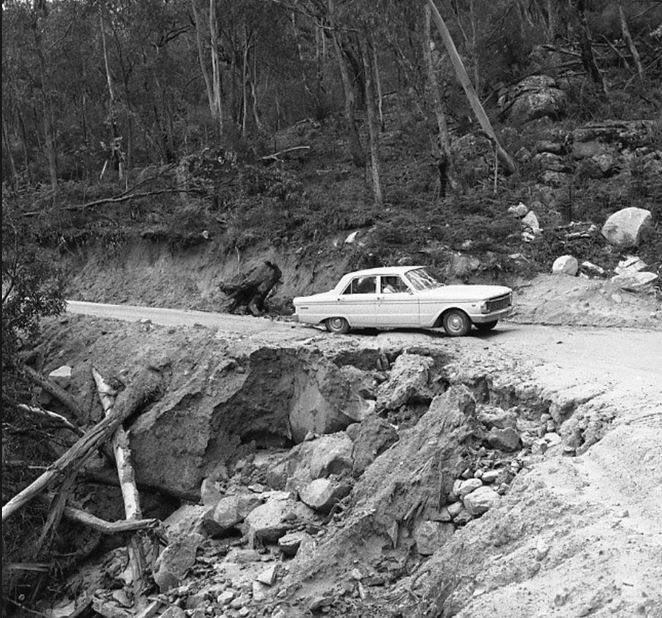
Honeysuckle Creek Tracking Station outside Canberra, with the temporary TV tower installed for Apollo 11 seen to the far right. Photo: Courtesy John Saxon.
In 1969 Curtin was the southern tip of Canberra and Watson was the northernmost edge. And the Moon was the next frontier to be reached in space.
Moon mania was gripping the planet, and Canberra played quite a role in the moon landing on 20 July that year.
Honeysuckle Creek Tracking Station 32km outside Canberra was built to support the NASA Apollo missions. Directed by Tom Reid (husband of former ACT Senator Margaret Reid AO), it was staffed by talented computer techs and electronics wizards who came to Canberra for the job.
Houses in Canberra were more available in the late 60s if you went all the way out to the greenfields areas in Curtin, so a lot of Canberra’s new space trackers lived there. The newish suburb was full of young families with enough kids for two primary schools (Curtin North and South).
Honeysuckle was 32km south west of Canberra down Naas road, over the Tharwa bridge and out of town on the newly named Apollo Road. In the early days the road was rugged, with part of it cutting through a farm and the trip could be slow. A Bedford bus was lost over the edge during the Station’s construction.
After driving through the bush, the Honeysuckle workers arrived at their long, low building next to the 26-metre communications dish, set in a 14 acre, radio-quiet valley surrounded by granite peaks.

A Ford Falcon eases past a washaway on the original road out to Honeysuckle Creek. Photo: Hamish Lindsay, courtesy of Colin Mackellar.
Once at work on shifts of up to 12 hours there was nowhere to go. Personnel weren’t allowed near the base of the dish due to radiation. Safety features included bright flashing red lights around the perimeter of the dish as well as a pulsating klaxon horn which was heard several kilometres away.
The young space trackers were gadget guys who loved their cars and worked long shifts out of town. Many remember flying along in their Ford Falcons and Datsun 1000s to get to work. Before the roads were improved it could be a rough trip and took hours after rain, when chains had to be put on. There were a few mishaps, with one car stuck sideways across the old Tharwa bridge.

Len Litherland, Ian Anderson and Hamish Lindsay apply snow chains for the muddy trip home from work. Photo: Courtesy Colin Mackellar.
Honeysuckle Creek Tracking Station was built in 1965 in Namadgi, as a NASA Earth station, one of three prime tracking sites for the NASA Apollo space missions. The three stations – Goldstone in California, Madrid in Spain and our own Honeysuckle Creek – gave NASA the ability to communicate with the astronauts and their spacecraft no matter which side of the Earth was facing the Moon.
During Apollo missions, the station was manned 24 hours a day on long 12-hour shifts. The Canberra trackers missed many Christmases and birthdays on shift and drank a lot of coffee. But it was exciting work, monitoring the astronauts, managing communications between them and NASA in the US. Off-shift, a few of the space trackers might end up at the Tharwa post 0ffice/pub, or the Statesman Hotel in Curtin.

Simulating an Apollo mission Evan Gull, Don Loughhead (background), Mike Evenett at console, Ian Grant on telephone. Photo: Hamish Lindsay courtesy of Colin Mackellar.
In 1969 they were working with cutting edge technology – many smoking all the while, using their NASA supplied ashtrays. The computer techs wore headsets, and the machines they used had no screens, and recorded onto reel to reel tapes. You can see one of the headsets and a console at the National Museum Tracking Apollo foyer display until 18 August.
Teletype messages were in constant use, like the emails of today, and were filed in large binders.
The machinery seems basic today, but the operators were highly skilled. All the Apollo missions were simulated many, many times before the astronauts took off, relying on the Honeysuckle Creek crew to keep them in communication with NASA on the Earth below when the Moon faced the southern hemisphere.

Bryan Sullivan and Gordon Bendall at the Univac 642B computer. Photo: Hamish Lindsay, courtesy Colin Mackellar.
TV was a new addition for the Apollo 11 mission in 1969 and a temporary TV relay tower was set up at Honeysuckle.
Bryan Sullivan, Technical Officer in the computer area has written about the day of the moon landing in July 1969:
“I took over from Don Loughhead monitoring the various data formats being transmitted to the Real Time Computers. Quietly and smoothly the night shift unplugged their headsets and withdrew from the activity as the fresh team got up to speed. Eventually all was calm, as we listened to the astronauts chatting away.”
However, as the moon landing approached the calm dissipated and the room filled up.
“By midday people began to file into the operations areas, secretaries, store men, clerks, maintenance men … Everyone stood well back though, as we scanned the rows of blinking lights on the computers with one eye and with our other eye on the flickering CCTV monitors, waiting for the first sign of a picture from the Moon.
“Suddenly the flickering blank greyness on the monitor gave way to a fuzzy black and white scene of a ladder upside down … I managed to stretch my headset cable far enough to look over … and know that I was viewing the historic scene, microseconds ahead of the rest of the world’s media.”
Fifty years later it’s hard to imagine a more exciting day at work!
Original Article published by Cass Proudfoot on The RiotACT.







